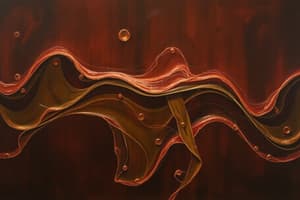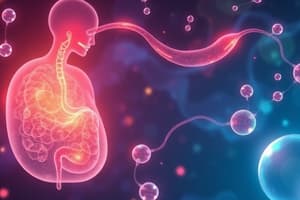Podcast
Questions and Answers
What configuration is described when the two hydrogen atoms stick out on the same side of the chain in a fatty acid?
What configuration is described when the two hydrogen atoms stick out on the same side of the chain in a fatty acid?
- Cis configuration (correct)
- Saturated configuration
- Trans configuration
- Partially hydrogenated configuration
How does the number of double bonds in a fatty acid affect its flexibility when in a cis configuration?
How does the number of double bonds in a fatty acid affect its flexibility when in a cis configuration?
- More double bonds increase flexibility
- Double bonds do not affect flexibility
- Flexibility is only determined by carbon chain length
- More double bonds decrease flexibility (correct)
Which of the following fatty acids contains three double bonds based on the provided structure?
Which of the following fatty acids contains three double bonds based on the provided structure?
- Linoleate (correct)
- Stearic acid
- Oleic acid
- Arachidonic acid
Which statement is true about fatty acids with a cis configuration?
Which statement is true about fatty acids with a cis configuration?
Which of these compounds is characterized by having an 18-carbon chain and three double bonds at specified positions?
Which of these compounds is characterized by having an 18-carbon chain and three double bonds at specified positions?
What makes up 95% of nutritional lipids?
What makes up 95% of nutritional lipids?
Which of the following statements about triglycerides is true?
Which of the following statements about triglycerides is true?
What is the ideal substrate for lingual lipase?
What is the ideal substrate for lingual lipase?
Which of the following is a major dietary source of lipids from animal sources?
Which of the following is a major dietary source of lipids from animal sources?
Which type of lipid accounts for less than 10% of dietary lipids?
Which type of lipid accounts for less than 10% of dietary lipids?
What pH range is lingual lipase active in?
What pH range is lingual lipase active in?
How much lipid do we typically ingest daily?
How much lipid do we typically ingest daily?
Which of the following is primarily a plant source of lipids?
Which of the following is primarily a plant source of lipids?
What is the primary function of mixed micelles in lipid absorption?
What is the primary function of mixed micelles in lipid absorption?
Which enzyme found in blood capillaries facilitates the hydrolysis of triglycerides?
Which enzyme found in blood capillaries facilitates the hydrolysis of triglycerides?
What must happen to dietary triglycerides before absorption can occur?
What must happen to dietary triglycerides before absorption can occur?
What is steatorrhea commonly associated with?
What is steatorrhea commonly associated with?
What can cause lipid malabsorption?
What can cause lipid malabsorption?
How much lipid loss in feces is typically observed in lipid malabsorption?
How much lipid loss in feces is typically observed in lipid malabsorption?
What is the role of chylomicrons in lipid transport?
What is the role of chylomicrons in lipid transport?
Fatty acids need to be partitioned into which phase for absorption?
Fatty acids need to be partitioned into which phase for absorption?
What is the primary function of gastric lipase in lipid digestion?
What is the primary function of gastric lipase in lipid digestion?
Which substances stimulate the secretion of pancreatic juices?
Which substances stimulate the secretion of pancreatic juices?
What role do bile salts play in fat digestion?
What role do bile salts play in fat digestion?
How does cholecystokinin (CCK) affect gastric motility?
How does cholecystokinin (CCK) affect gastric motility?
What triggers the release of secretin in the intestine?
What triggers the release of secretin in the intestine?
Which digestive enzyme is primarily responsible for fat digestion in the small intestine?
Which digestive enzyme is primarily responsible for fat digestion in the small intestine?
In which group of individuals is gastric and lingual lipase crucial for digestion?
In which group of individuals is gastric and lingual lipase crucial for digestion?
What is the effect of bicarbonate released by the pancreas?
What is the effect of bicarbonate released by the pancreas?
What is the primary enzyme that hydrolyzes cholesteryl esters?
What is the primary enzyme that hydrolyzes cholesteryl esters?
Which product is NOT formed during the degradation of phospholipids?
Which product is NOT formed during the degradation of phospholipids?
What products result from lipid digestion in the jejunum?
What products result from lipid digestion in the jejunum?
What percentage of bile salts is typically lost in feces after reabsorption?
What percentage of bile salts is typically lost in feces after reabsorption?
Where does the resynthesis of triacylglycerols and cholesteryl esters primarily occur?
Where does the resynthesis of triacylglycerols and cholesteryl esters primarily occur?
What is primarily absorbed by the enterocytes following lipid digestion?
What is primarily absorbed by the enterocytes following lipid digestion?
Which enzyme acts on lysophospholipid to form glycerylphospholipid base?
Which enzyme acts on lysophospholipid to form glycerylphospholipid base?
What role do bile salts play in cholesteryl ester degradation?
What role do bile salts play in cholesteryl ester degradation?
Flashcards are hidden until you start studying
Study Notes
Lipid Digestion & Absorption
- Mixed Micelles transport poorly water-soluble lipids like cholesterol and fat-soluble vitamins (A, D, E, K).
- Bile Salts are essential for efficient lipid absorption, solubilizing ingested lipids.
- Chylomicrons are formed in enterocytes and transport fats via lymphatic capillaries into the bloodstream.
- Lipoprotein Lipase, found on blood capillary walls, hydrolyzes triglycerides in chylomicrons into fatty acids and glycerol for energy or storage.
Triglyceride Assimilation
- Dietary Triglycerides must be hydrolyzed into fatty acids, monoglycerides, and glycerol before absorption.
- Micelles form to promote absorption of fatty acids into the intestinal wall.
- Chylomicrons are formed from the resynthesis of triglycerides from absorbed glycerol and fatty acids.
Malabsorption
- Lipid Malabsorption leads to elevated lipid excretion in feces due to impaired digestion or absorption.
- Conditions like cystic fibrosis (CF) and short bowel syndrome can cause lipid malabsorption.
- Steatorrhea refers to significant fat losses (around 30g/day) in stool, including fat-soluble vitamins and essential fats.
- Bile Salt Deficiency caused by liver disease or bile duct obstruction contribute to steatorrhea.
Sources of Fats for Metabolism
- Dietary Fats are the primary source.
- Stored Fat in adipose tissue is another source.
- Synthesized Fat from excess carbohydrates is a third source.
Dietary Composition of Lipids
- We consume approximately 100g of lipids daily.
- Triglycerides make up over 90% of our lipid intake.
- Other lipids: cholesterol, cholesteryl esters, phospholipids, and free fatty acids.
Dietary Sources
- Animal Sources: Dairy products (milk, cheese, butter), meat, eggs, fish, poultry.
- Plant Sources: Cooking oils, nuts, seeds, avocados.
Digestion in Mouth
- Lingual Lipase is secreted by the tongue.
- Works optimally at low pH (2.0-7.5).
- Primarily breaks down short-chain triglycerides (e.g., milk fat).
Digestion in Stomach
- Gastric Lipase is secreted in small quantities.
- Less effective on long-chain fatty acids; mainly works on short to medium chain fatty acids.
- Plays a significant role in lipid digestion for infants and those with pancreatic insufficiency.
Digestion in Small Intestine
- Main Site for fat digestion due to pancreatic lipase and bile salts.
- Bile Salts are emulsifiers for fats, increasing their surface area for pancreatic lipase action.
- Pancreatic Juices are secreted upon stimulation by:
- Acidic gastric content entering the duodenum
- Secretin and cholecystokinin (CCK) hormones.
Control of Digestion
- Cholecystokinin (CCK) is released by the duodenum in response to lipids and proteins, stimulating gallbladder bile release, decreasing gastric motility, and promoting satiety.
- Secretin is released in response to low pH of chyme, stimulating pancreatic bicarbonate secretion for neutralization.
- Bile Salts are reabsorbed after aiding lipid absorption.
Cholesteryl Ester Degradation
- Dietary cholesterol is mainly in the free form, with a small portion as cholesteryl esters.
- Pancreatic Cholesteryl Ester Hydrolase (Cholesterol Esterase) hydrolyzes cholesteryl esters to cholesterol and free fatty acids.
- Bile Salts enhance the activity of this enzyme.
- Phospholipase A2 removes one fatty acid from phospholipids, forming lysophospholipids.
- Lysophospholipase further breaks down lysophospholipids.
Lipid Absorption
- Free Fatty Acids, Cholesterol, 2-monoacylglycerol: Products of lipid digestion in the jejunum.
- Mixed Micelles deliver these products to the enterocyte brush border membrane.
- Enterocytes absorb the lipids.
- Bile Salts are largely reabsorbed back into circulation with only a small amount lost in feces.
Resynthesis
- Absorbed lipids are transported to the endoplasmic reticulum of enterocytes.
- Triglycerides and cholesteryl esters are re-synthesized in the enterocytes.
Studying That Suits You
Use AI to generate personalized quizzes and flashcards to suit your learning preferences.




